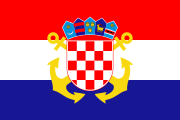Croatian Navy
| Croatian Navy | |
|---|---|
|
Emblem of the Croatian Navy
|
|
| Active | 1991-present |
| Country |
|
| Type | Navy |
| Size | 1,442 personnel 29 vessels |
| H/Q | Lora naval base Split |
| Patron | Saint Nicholas |
| March | Mi smo hrvatski mornari (We are the Croatian sailors) |
| Anniversaries | September 18 - first recorded Croatian naval victory (under duke Branimir against Venetians near Makarska in 887) |
| Engagements |
Croatian War of Independence Operation Atalanta Operation Triton |
| Decorations |
|
| Commanders | |
| Commander | Rear Admiral Predrag Stipanović |
| Deputy Commander, Chief of Naval Staff |
Ship-of-the-line cpt. Milan Blažević |
| Notable commanders |
Fleet Admiral Sveto Letica, Admiral Vid Stipetić, Viceadmiral Zdravko Kardum, Rear Admiral Janko Vuković |
| Insignia | |
| Naval Ensign |  |
| Naval Jack |  |
|
|
|
|
|
|
|
|
|
|
The Croatian Navy (Croatian: Hrvatska ratna mornarica) is a branch of the Croatian Armed Forces. It was formed in 1991 from what Croatian forces managed to capture from the Yugoslav Navy during the Breakup of Yugoslavia and Croatian War of Independence. In addition to mobile coastal missile launchers, today it operates 29 vessels, divided into Navy Flotilla for traditional naval duties and the Croatian Coast Guard. Five missile boats form Croatian fleet's main offensive capability.
Since the ninth century, the Duchy of Croatia (later Kingdom) engaged in naval battles, struggling to maintain control over the eastern Adriatic coast and Adriatic merchant routes. Commemorating the first recorded Croat naval victory, when the subjects of Croatian duke Branimir defeated the Venetian naval expedition on September 18, 887, the Croatian Navy Day is celebrated yearly on September 18. Croatian fleet was particularly active under duke Domagoj and king Petar Krešimir IV. Royal Croatian-Dalmatian navy with 12-15 galleys existed under Louis I in central Dalmatia in the 14th century. Afterwards Venetian Republic established control over most of Croatian coast until 1797. Modern foundations of Croatian Navy can be traced back to Austro-Hungarian Navy (1797-1918) and Yugoslav Navy (1918-1941, 1942-1991) when Croatia was a constituent part of these states.
When Croatia was a part of Austria-Hungary, its Adriatic coast was essentially the only access to sea this Central European state had. A Habsburg arsenal and a naval shipyard were established in Kraljevica in 1729, while naval bases, schools, shipyards, headquarters and a naval academy were later set up in Pula and Rijeka. Navy's emblem included Croatian coat of arms. Many highly ranked officers came from Croatia: grand admiral Maximilian Njegovan, ship-of-the-line captain Janko Vuković Podkapelski and others. In 1885, 44.9% of sailors and NCOs and 10.3% of naval officers were ethnically Croatian, while in 1910 those shares dropped to 29.8% and 9.8%, respectively. At the end of October 1918, while Austria-Hungary was falling apart and the war was drawing to an end, emperor Charles handed the Navy over to the Zagreb People's Council, which promoted Vuković to the rank of the rear admiral and appointed him as a fleet commander. Croatian flag was hoisted on all ships in Pula (including, most notably, the flagship SMS Viribus Unitis) and some in Kotor, but the Entente navies soon captured nearly all vessels and divided them among themselves.
...
Wikipedia

